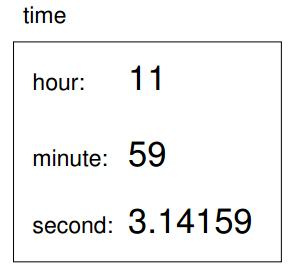
C++ Time结构体
我们定义一个数据类型称为Time,用于记录一天的时间,以此作为第二例自定义数据结构。小时、分、秒是构成时间的各种信息,这些都是结构体的实例变量。
The first step is to decide what type each instance variable should be. It seems clear that hour andminute should be integers. Just to keep things interesting, let’s make secondadouble, so we can record fractions of a second. Here’s what the structure definition looks like: 第一步要决定每个实例变量的类型。小时和分应该是整型。这回我们搞个有趣的,把秒定义为double型,以便记录秒的小数部分。下面是结构体的定义代码:
struct Time {
int hour, minute;
double second;
};我们可以按常规方式创建Time对象:
Time time = { 11, 59, 3.14159 };此对象的状态图如下:

“实例”一词有时用于探讨对象的问题,因为每个对象都是某种类型的实例(或示例)。之所以称之为实例变量,是因为某种类型的每个实例都是该类型实例变量的一个备份。